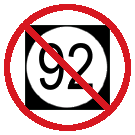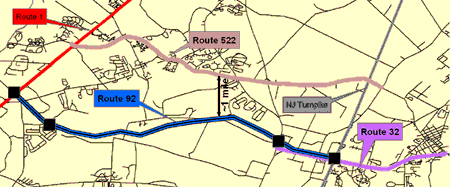 |
|||||||||||||
|
|
|||||||||||||
 |
|||||
|
Viable Alternatives to the Construction of Route 92 A combination of roadway improvements to both Rt. 522, Rt. 1, and Rt. 32, plus operations and system improvements like turn lanes, signal changes and expansion of the Exit 8A toll booth, would improve traffic flow east-west between Exit 8A and Rt. 1 at much less cost and no disruption to the environment. And then we can use the money that’s been borrowed for Route 92 on “smart growth” transportation projects that make sense for New Jersey. A Community-Centered Roundtable The proponents of Route 92 have never sought the input of the stakeholders who would be hurt the worst by it. In contrast, the Penn’s Neck (Millstone) Bypass used a community-centered roundtable mediated by the Voorhees Transportation Policy Institute at Rutgers University, to achieve a solution that works for the whole region. The roundtable could involve all stakeholders in improving transportation in the region, and be mediated by a trusted intermediary like Rutgers or the new Municipal Land Use Center at The College of New Jersey. Congressman Rush Holt, who has a strong reputation as a conservationist, secured the funding for MLUC. What better way to put it to work for us, in Mr. Holt’s own district? We strongly feel that Governor Corzine and Congressman Holt need to take the lead in turning the State and Federal governments away from Route 92’s one-sided coercion run by the monied interests, and toward a mediated roundtable process that works for all of us. Some alternatives that such a roundtable could take up include: County Route 522
We have better alternatives to constructing a hugely expensive superhighway ― the use of the existing Middlesex County Rt. 522. Much of Rt. 522 conforms to the specifications of Rt. 92 – it is a four-lane, full shoulder, new dualized highway that connects with Rt. 1 at the next intersection north of Ridge Rd. It is about 1-2 miles north of Rt. 92 throughout its length and has plenty of spare lane capacity to carry traffic. And 522 is free, but 92 would be a toll road. While its current connection to the Turnpike is a one-lane overpass without exit ramps (adjacent to the emergency patrol overpass), the creation of a full set of ramps and a new bridge and alignment of Rt. 522 in that area would consume far less land and create far fewer impacts than the construction of Rt. 92. It would also help concentrate warehousing operations there rather than spreading them out across the farmlands to be taken by the Turnpike in South Brunswick Township if Route 92 is built. South Brunswick has already approved a realignment of Rt. 522 in the area of the Turnpike to better serve warehouse truck traffic that would benefit from a more direct connection to the Turnpike. State Route 32 Transportation Projects for Smart Growth At the state’s First Annual Transportation Conference, former Governor McGreevey charged a new blue-ribbon transportation panel with implementing his six-point plan for transportation improvement:
Additionally, State Senator Peter Inverso has proposed using the Route 92 funds to help build a Bus Rapid Transit (BRT) system along Route 1. We think this is an excellent idea that would use our public money the right way - to help relieve traffic on Route 1, instead of creating more of it. NJDOT Commissioner Lettiere agrees with us when we say that building more roads just leads to more congestion. The state now has over $5 billion in needed transportation projects that we can’t fund, including 2,000 crumbling bridges. Why should we fund harmful roads like 92 when the money can go toward much better things? We can take the money that’s been earmarked for 92, and utilize it on “smart growth” transportation projects that will help New Jersey instead of hurting it. Such transfers have already been done to the Garden State Expressway, NJ Transit, and the E-ZPass Consortium. It can be done even more easily once the NJ Turnpike, Garden State Parkway, and the Atlantic City Expressway authorities are merged. Why not spend our public money the smart way? Can you help us stop 92?
|
|||||
